Adirondack Wetlands

A wetland is a land area that is saturated with water for at least part of the year. Adirondack wetlands, like other freshwater wetlands, feature species adapted to life in a saturated environment. Wetlands are shallow; water depth is below six feet. This allows growth of rooted or anchored plants, such as water lilies, and also free floating plants without attachment to the bottom, like duckweed.
Wetlands play a crucial role in the balance of nature.
- They modulate the flow of water, helping to reduce flooding and erosion.
- Wetlands also assist in water purification by filtering out sediments.
- Finally, wetlands are of major significance to scores of plant and animal species, providing desirable habitat for fish and wildlife.
An estimated 14% of the land surface of the Adirondacks is wetland. There are several types of freshwater wetlands in the Adirondacks: marshes, peatlands (bogs and fens), swamps, and open river corridors.
Adirondack Marshes
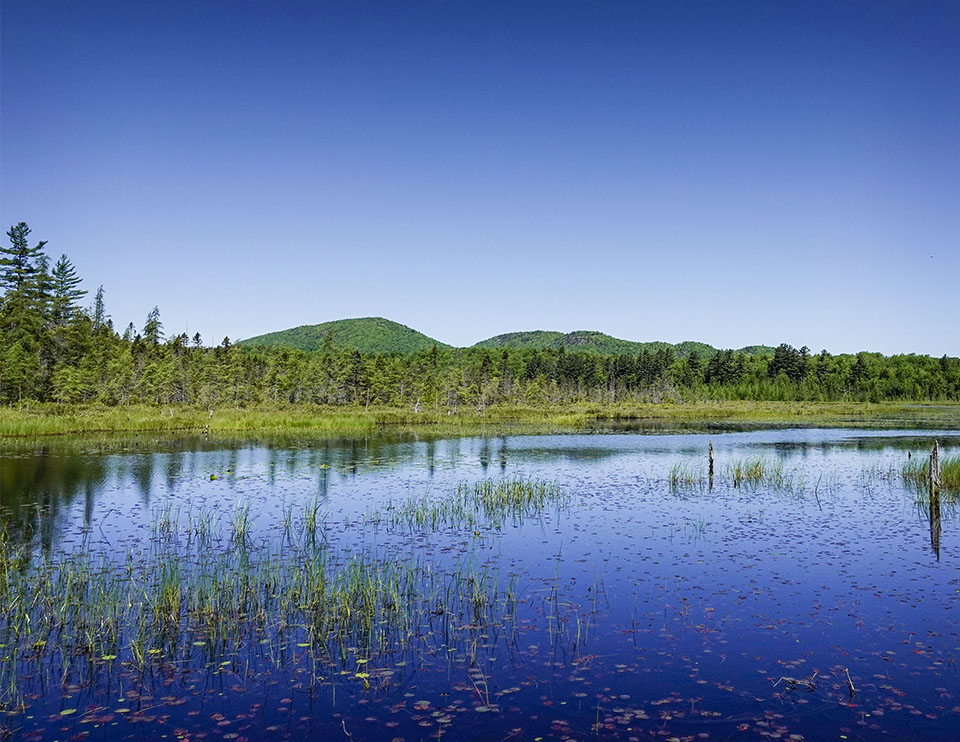
Marshes are the wettest of Adirondack wetlands, varying in depth from a few inches to six feet.
- A marsh is a mineral-rich wetland where the dominant vegetation consists of herbaceous plants that are rooted in hydric soils, but not in peat. Marshland is found along the margins of ponds and lakes, forming a transition between the aquatic and terrestrial ecosystems. You can also find marshes in the backwater regions of rivers and streams and interspersed with other wetlands.
- Marshes are nutrient-rich from the residue of upland drainage. They are supplied with oxygenated, slowly-moving water. As a result, they are highly productive environments, fostering the cycles of growth and decay necessary for plant and animal life.
- Marshes are dominated by herbaceous (rather than woody) plant species, such as grasses, rushes, or reeds. This distinguishes marshes from swamps, where trees dominate the plant life.
Marshes also have one of the highest levels of habitat diversity. The vegetation in these wetlands – the water lilies, cattails, bulrushes, Pickerelweed, loosestrifes, and arrowheads which flourish in these areas – provides nesting habitat, food, and cover for many waterfowl and other wildlife.
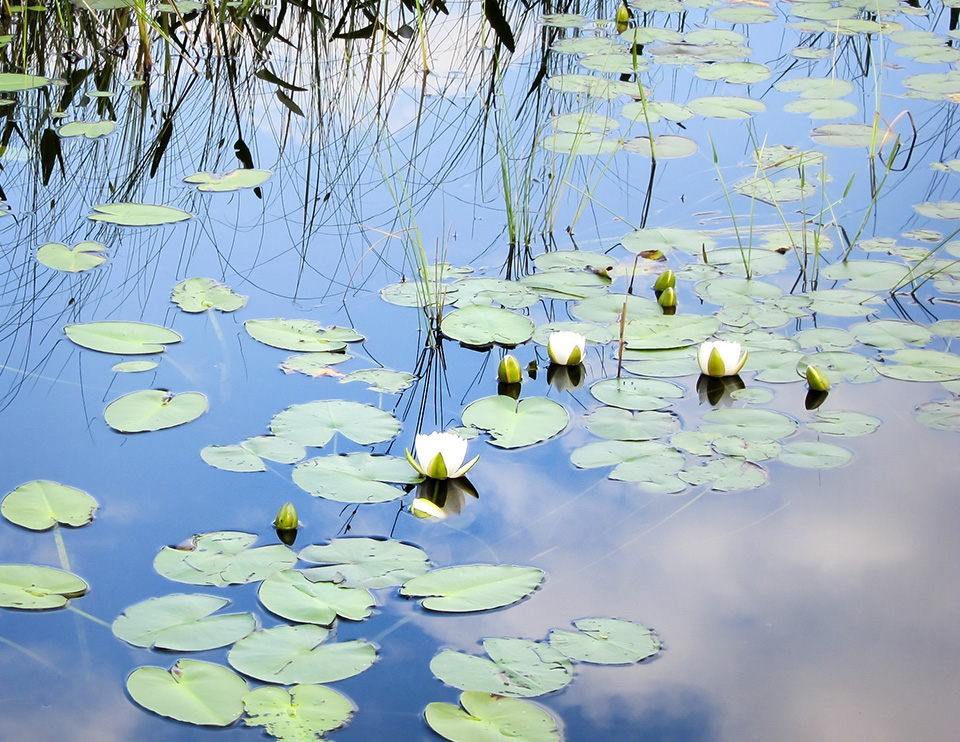
Many different species of wetland plants flourish in Adirondack marshes.
- Floating plants, such as Yellow Pond Lily and White Water-lily, are anchored to the bottom by roots and have long stalks to leaves that float on the surface of the water.
- At lower water depths, emergents (such as Pickerelweed and Cattail) flourish.
- Bladderworts, such as Horned Bladderwort, also thrive in marshland; these are submersed free-floating plants featuring tiny bladders attached to the leaves, which trap and digest very tiny animals. Northern Pipewort and other emergent aquatic plants are also found in marshes.
- Blue Flag also grows in profusion in the shallower water of the margins of marshes.
- Plants which flourish on the edge of the marsh are related to rhododendrons and include Leatherleaf, Meadow Sweet, Steeplebush, and Sheep Laurel.
Wildlife also capitalizes on the richness of Adirondack marshes.
- North American River Otters and muskrats can be seen throughout the year on many marshes. Otters feed on the fresh-water mussels and clams in the marsh.
- Look for White-tailed Deer on marsh edges.
- Snapping Turtles make their home in marshy areas. Painted Turtles are often seen sunning on floating logs in the open water areas. Green Frogs and Spring Peepers can be heard calling from the edges of the marsh.
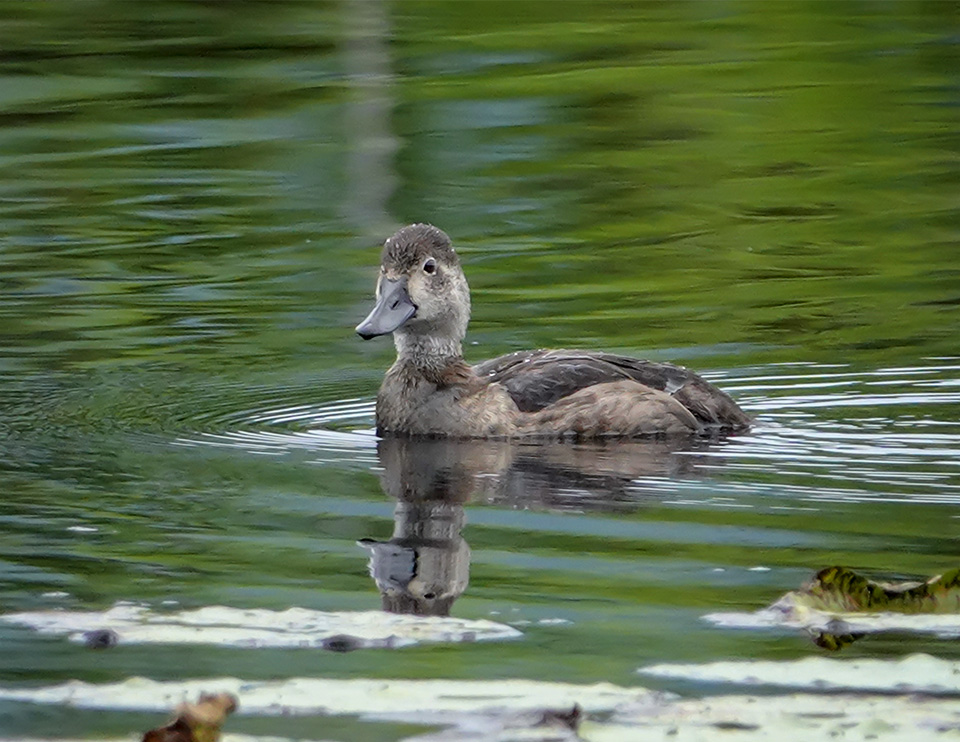
Many species of birds can also be seen or heard on Adirondack marshes.
- Several different species of ducks nest in marshes, including Ring-necked Ducks, American Black Ducks, Common Mergansers, Wood Ducks, and Mallards.
- Look for Red-winged Blackbirds perching on snags and shrubs on marshland.
- Swamp Sparrows may be found nesting among the cattails and shrubs along the margins of marshes.
- American Bitterns often forage for food in the wetland vegetation along the edges of the water.
- Great Blue Herons can also be seen on the edges of the water.
Adirondack Peatlands: Bogs and Fens
A peatland is a type of wetland where wet and cold conditions prevent plants from decomposing. Dead plants accumulate as peat soil, often for millennia. Peatlands are characterized by water-saturated peat soil, composed primarily of living or dead Sphagnum moss.
There are two different types of peatlands in the Adirondacks: bogs and fens. Both are lowland boreal communities which are climate dependent and require low temperatures and year-round moisture. Both contain boreal species of plants and animals that are at the southern extremes of their ranges. There are an estimated 50,000 acres of bogs and fens in the Adirondacks.
Adirondack Bogs
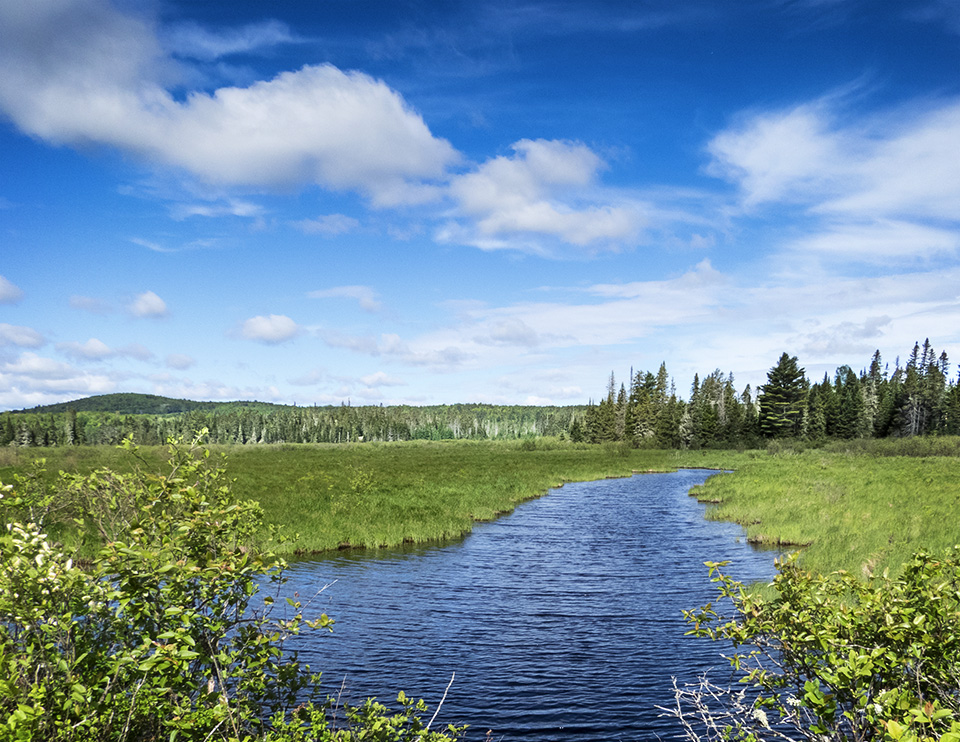
Bogs are nutrient-poor, acidic wetlands dominated by sphagnum mosses, sedges, and shrubs and evergreen trees rooted in deep peat. Bogs are more isolated from the flow of both surface water and groundwater than other wetlands. Bogs are dependent on rain for most of their water supply. They rely on windblown particles for mineral nutrients, such as calcium and phosphorus. Bogs – like Spring Pond Bog, Bloomingdale Bog, Barnum Bog, and Massawepie Mire – are the most common type of peatland in the Adirondack Park.
Because bogs are highly acidic, with most of their nutrients locked up in decayed plant materials, they are not congenial environments for plants and animals.
- Sphagnum moss can thrive under these conditions, forming a mat across the open water of a bog pond and withdrawing nutrients.
- This process contributes to the acidity of the water, inhibiting growth, decay, and nutrient cycling by making it difficult for decomposer organisms to function.
- The result is a nutrient desert, where many plants are unable to thrive.
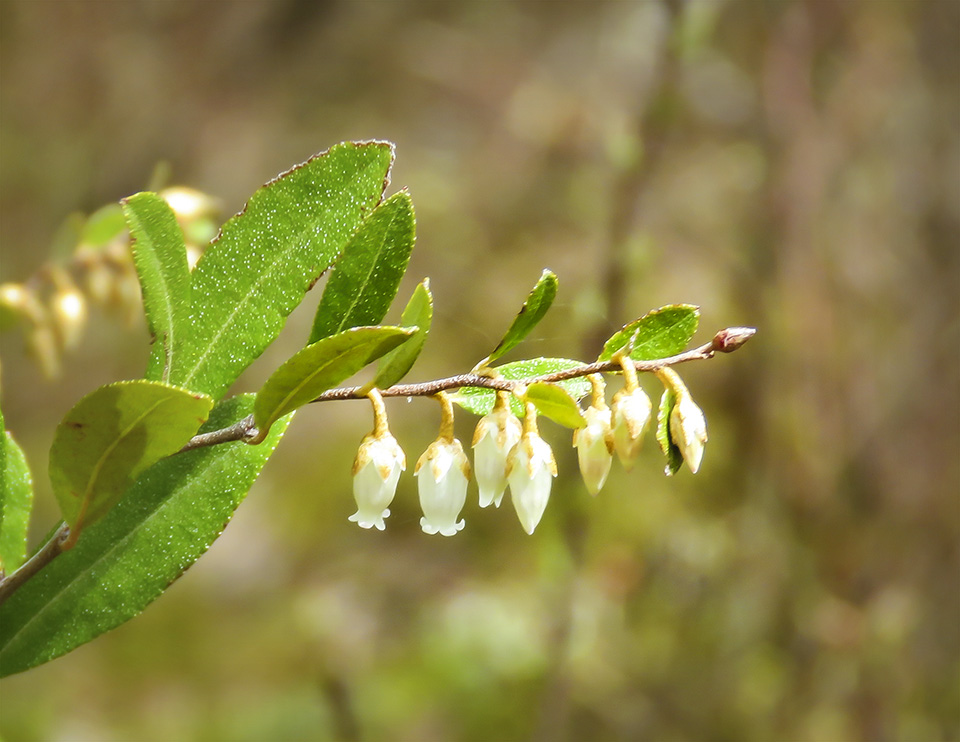
The trees and shrubs which grow in bogs are those which have evolved strategies for dealing with this difficult environment.
- Tamaracks, also known as the Eastern Larch or American Larch, are coniferous trees which turn a golden yellow in fall before shedding their needles.
- Tamaracks are often found growing in close proximity to the Black Spruce, another indicator plant of boreal bogs. Black Spruce growing in bogs tend to be very small because the harsh environment causes them to grow very slowly, so a tree only a few feet high may be quite old.
- Shrubs characteristic of bogs include evergreen members of the heath family, such as Sheep Laurel, Bog Laurel, Leatherleaf, Bog Rosemary, and Labrador Tea. These plants are well suited to bog life because they have leaves which retard evaporation through such adaptations as waxy coatings, rolled edges, and fuzzy undersides.
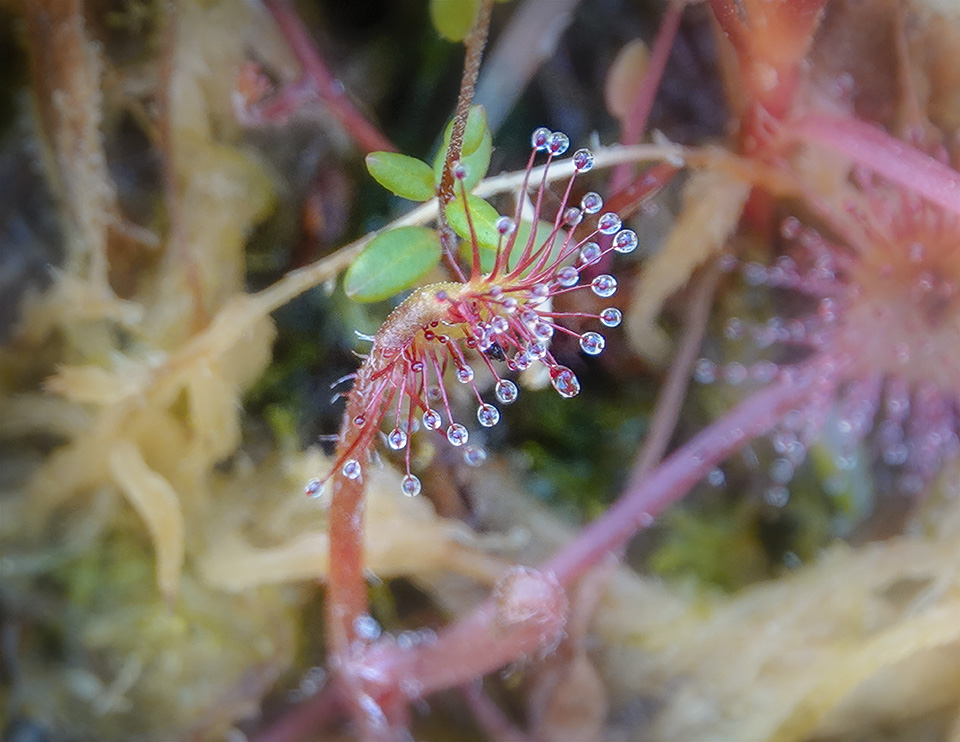
Bog-dwelling wildflowers are limited to those able to survive in the nutrient-poor environment.
- Pitcher plants and sundews have developed an adaptation that provides a supplemental nutrient source from captured insects. The Pitcher Plant, for instance, has tubular leaves surrounding the base of the plant. Insects enter the mouth of the plant and are trapped by the hairs. They then drown in the leaf fluid and are digested by enzymes and bacteria. The nutrients absorbed from the insects supplement the nutrients absorbed by the roots. Bladderwort and Roundleaf Sundew, which are also carnivorous, can also be found in Adirondack bogs.
- Another plant which thrives in Adirondack bogs is Buckbean, which produces produces clusters of star-like white flowers in spring and early summer. This plant, which grows up to about ten inches tall, flourishes in the wet soil of the bog and can usually be seen blooming in June.
- Other wetland plants that flourish in bogs include Cottongrass and Marsh Cinquefoil. The latter is a member of the rose family and produces reddish purple flowers in late June. Several species of Cottongrass can be seen in bogs; some bloom in late spring and early summer, while others bloom in late summer and fall.
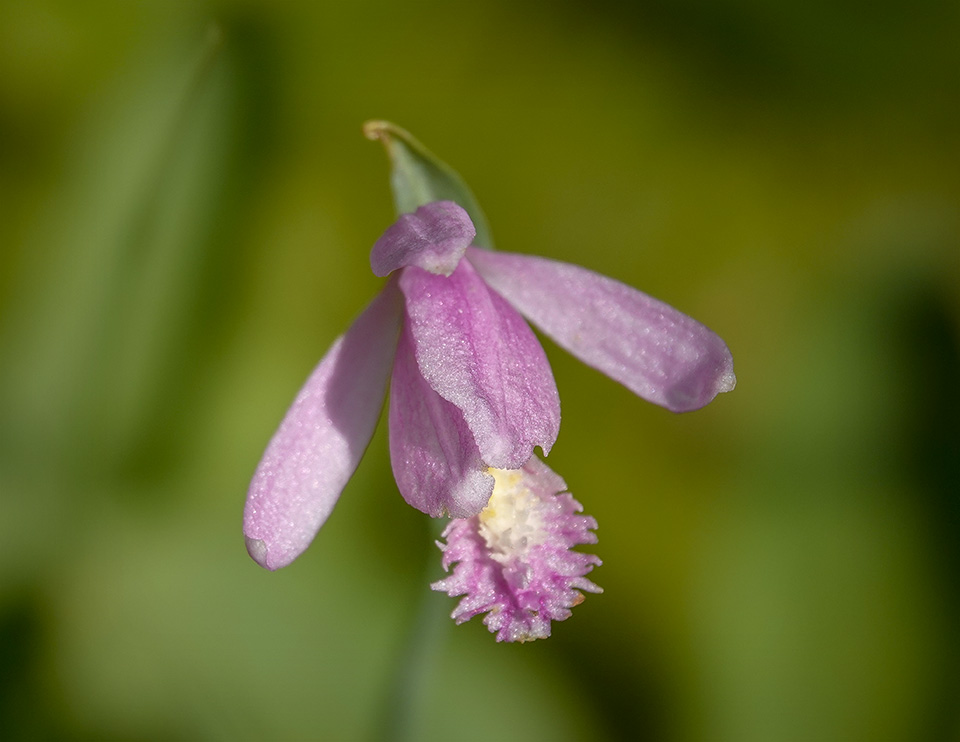
Bogs also host a variety of orchids that thrive in wet soil.
- Grass Pink generally grows in full sun in bogs and fens. It gets its name from the long, narrow, grass-like leaves. The vibrant pink blossoms are sweet-smelling and usually bloom in the Adirondack region late June or early July.
- Another bog-dwelling orchid – Rose Pogonia – also produces pink flowers and blooms beginning in late June. The Latin name "Pogonia" means beard – a reference to the bearded lip on the flower. Rose Pogonia is listed as an obligate wetland, meaning that it grows only in wetlands, usually in full sun.
- White-fringed Orchids also bloom in bogs, usually in late June or early July. The common name is a reference to the fringed lip on each small flower.
- Bogs also host Little Club-spur Orchids, which produce greenish-white flowers in the Adirondack region in late July or early August.
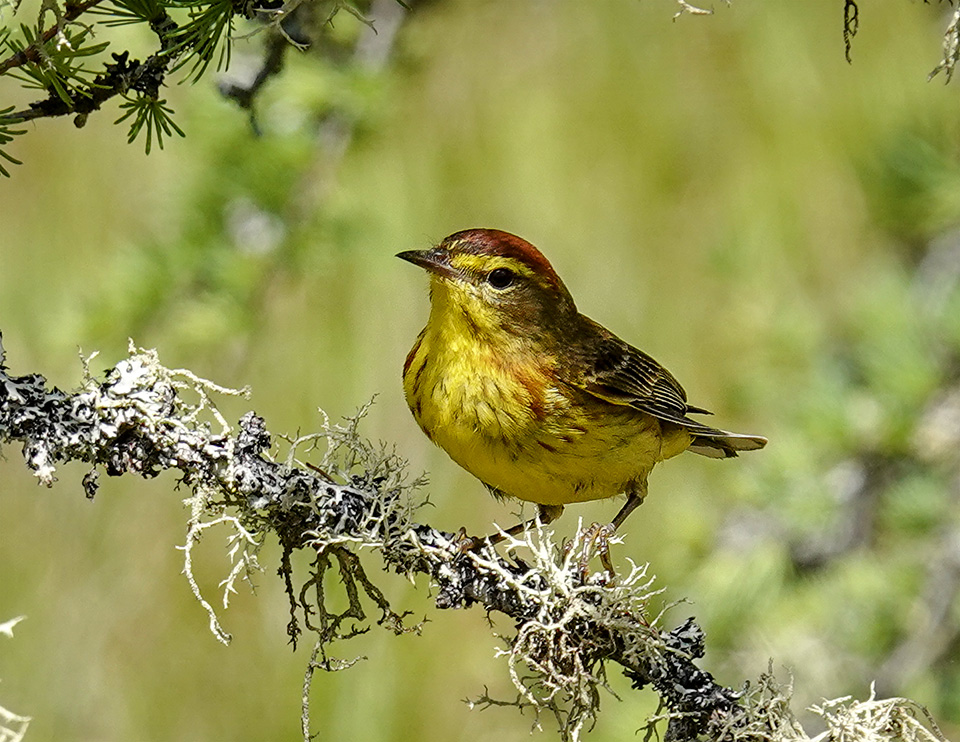
Adirondack bogs represent a major draw for birdwatchers. Lowland boreal communities attract a variety of migratory birds, who use this habitat for nesting, eating, and roosting, probably because boreal habits like bogs are rich in insect life during the summer.
- Several species of birds nest in bogs, including the Palm Warbler, which nests in sphagnum moss, and the Lincoln's Sparrow, which nests in shrubs on the bog. The Yellow-bellied Flycatcher also breeds in peat lands.
- Other boreal birds characteristic of a bog habitat include the Canada Jay and Black-backed Woodpecker.
- Yellow-rumped Warblers, Nashville Warblers, Alder Flycatchers, Northern Waterthrush, and Cedar Waxwings are also seen in this habitat or foraging on the forested edges of the bog.
Adirondack Fens
Fens are similar to bogs in that they also have peat soils. The feature that distinguishes fens from bogs is the fact that fens receive water from the surrounding watershed in inflowing streams and groundwater, while bogs receive water primarily from precipitation. As a result, the chemistry of fens is less acidic.
Fens reflect the chemistry of the geological formations through which these waters flow. As a consequence, there is much variation among fens with respect to acidity, and they often do not have the extreme acid conditions associated with bogs.
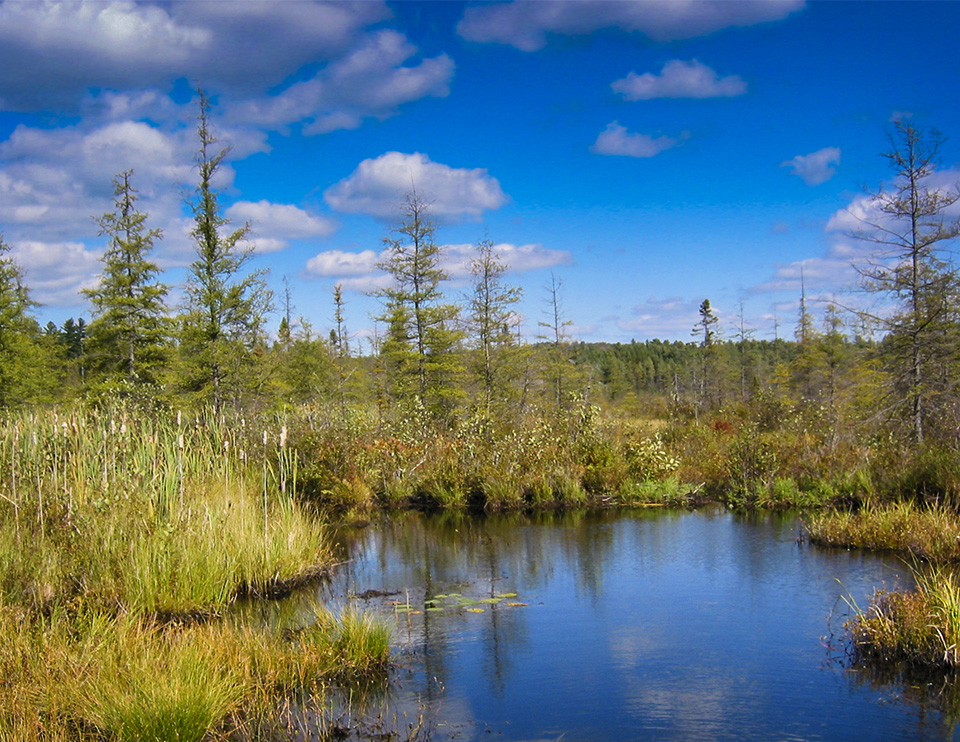
The plants which grow in a fen tend to be more varied than those in a bog.
- In contrast to bogs (where heaths are more plentiful), fens tend to be dominated by sedges.
- The plant life of acid fens is similar to bogs and includes Black Spruce, Tamarack, willow, birch, orchids, and Leatherleaf. Wildlife species groups associated with acidic fens are similar to those associated with bogs, such as Palm Warblers and Wood Frogs.
- Neutral to alkaline fens with the most mineral enrichment are less like bogs, feature less sphagnum, and more closely aligned with wet meadows and marshes.
The wetland near the boardwalk across Heron Marsh is categprozed as an Inland Poor Fen. Athough the wetland areas bordering the Bloomingdale Bog Trail are categorized as Dwarf Shrub Bogs, those areas bordering Two Bridge Brook are fens. The Northern Forest Atlas has produced a video with aereal footage highlighting the mosaic of fens and bogs along the Bloomingdale Bog Trail.
Adirondack Swamps
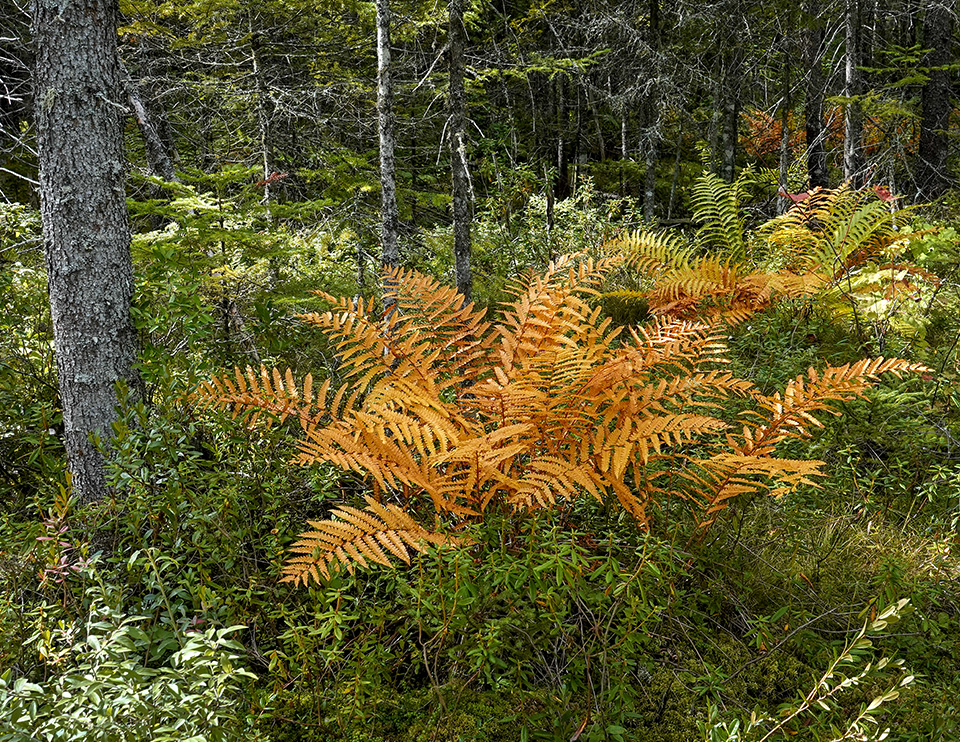
Swamps are freshwater wetlands dominated by trees rooted in hydric soils, not in peat. These are areas where woody vegetation grows in soil that, while often waterlogged, is seldom flooded by more than a few inches. Swamps may include either or both hardwood shrubs or trees and conifers.
- Shrub swamps are found along the banks and in the floodplain of streams and rivers. Only the most resilient plants grow here, due to the scouring action of flooding and winter ice movements which prevents the development of a mature forest. Alders, willows, and Sweetgale are common in such areas, as are Northern Wild Raisin and mountain holly.
- Wooded swamps occupy places where the soil is more mineral in composition and flooding is less deep and of shorter duration. Conifers such as Balsam Fir, Tamarack, and Northern White Cedar tend to dominate interior and high-elevation wetlands in the central part of the Adirondacks, where peaty soils and severe winters prevail.
Ferns and mosses are common in swampy areas. These areas also host shade-loving wildflowers, including Common Wood Sorrel and Goldthread. Birds commonly seen or heard in these areas include the Golden-crowned Kinglet, Winter Wren, and Nashville Warbler.
References:
Donald D. Cox. A Naturalist's Guide to Wetland Plants. An Ecology for Eastern North America (Syracuse University Press, 2002), pp. 1-11, 64-93.
John Eastman. Swamp and Bog. Trees, Shrubs, and Wildflowers of Eastern Freshwater Wetlands (Stackpole Books, 1995), p. xiv.
Paul A. Keddy. Wetland Ecology. Principles and Conservation (Cambridge University Press, 2010), pp. 17-24.
Ronald B. Davis. Bogs & Fens. A Guide to the Peatland Plants of the Northeastern United States and Adjacent Canada (University Press of New England, 2016), pp. 11-31.
Meiyin Wu and Dennis Kalma. Wetland Plants of the Adirondacks: Herbaceous Plants and Aquatic Plants (Trafford Publishing, 2011).
Donald J. Leopold and Lytton John Musselman. Wildflowers of the Adirondacks (Johns Hopkins University Press, 2020), pp. 6-17.
Jerry Jenkins. Climate Change in the Adirondacks: The Path to Sustainability (Cornell University Press, 2010), pp. 33-43.
Jerry Jenkins. The State of the Adirondack Lowland Boreal. Part I. Composition & Geography (Wildlife Conservation Society and Nature Conservancy, 13 September 2004.
Northern Forest Atlas. Bloomingdale Bog. Retrieved 27 January 2022.
Northern Forest Atlas. A Walk into a Bog. Retrieved 27 January 2022.
Northern Forest Atlas. Introduction to Wetlands. Terms and Examples. Retrieved 2 February 2022.
Northern Forest Atlas. Bog Ponds and Shoreline Bogs. Retrieved 2 February 2022.
Randall Kolka and Carl Trettin, "Terrestrial Wetlands," in Second State of the Carbon Cycle Report (SOCCR2): A Sustained Assessment Report (U.S. Global Change Research Program, 2018). Retrieved 28 October 2019.
Adirondack Park Agency. Freshwater Wetlands. 20 August 2013. Retrieved 14 January 2017.
New York State Department of Environmental Conservation. New York Natural Heritage Program. Ecological Communities of New York State. Second Edition (March 2014). Retrieved 14 January 2017.
David J. Welsch et al. Forested Wetlands: Functions, Benefits and the Use of Best Management Practices (United States Environmental Protection Agency. NA-PR-01-95.) Retrieved 2 February 2022.
New York State. Department of Environmental Conservation. Environmental Resource Mapper. Retrieved 19 December 2019.
New York Natural Heritage Program. 2022. Online Conservation Guide for Alpine Sliding Fen. Retrieved 2 February 2022.
New York Natural Heritage Program. 2022. Online Conservation Guide for Black Spruce-Tamarack Bog. Retrieved 2 February 2022.
New York Natural Heritage Program. 2022. Online Conservation Guide for Deep Emergent Marsh. Retrieved 2 February 2022.
New York Natural Heritage Program. 2022. Online Conservation Guide for Dwarf Shrub Bog. Retrieved 2 February 2022.
New York Natural Heritage Program. 2022. Online Conservation Guide for Hemlock-Hardwood Swamp. Retrieved 2 February 2022.
New York Natural Heritage Program. 2022. Online Conservation Guide for Medium Fen. Retrieved 2 February 2022.
New York Natural Heritage Program. 2022. Online Conservation Guide for Northern White Cedar Swamp. Retrieved 2 February 2022.
New York Natural Heritage Program. 2022. Online Conservation Guide for Patterned Peatland. Retrieved 2 February 2022.
New York Natural Heritage Program. 2022. Online Conservation Guide for Red Maple-Tamarack Peat Swamp. Retrieved 2 February 2022.
New York Natural Heritage Program. 2022. Online Conservation Guide for Rich Graminoid Fen. Retrieved 2 February 2022.
New York Natural Heritage Program. 2022. Online Conservation Guide for Rich Hemlock-Hardwood Peat Swamp. Retrieved 2 February 2022.
New York Natural Heritage Program. 2022. Online Conservation Guide for Rich Shrub Fen. Retrieved 2 February 2022.
New York Natural Heritage Program. 2022. Online Conservation Guide for Rich Sloping Fen. Retrieved 2 February 2022.
New York Natural Heritage Program. 2022. Online Conservation Guide for Sedge Meadow. Retrieved 2 February 2022.
New York Natural Heritage Program. 2022. Online Conservation Guide for Shallow Emergent Marsh. Retrieved 2 February 2022.
New York Natural Heritage Program. 2022. Online Conservation Guide for Shrub Swamp. Retrieved 2 February 2022.
New York Natural Heritage Program. 2022. Online Conservation Guide for Silver Maple-Ash Swamp. Retrieved 2 February 2022.
New York Natural Heritage Program. 2022. Online Conservation Guide for Spruce-Fir Swamp. Retrieved 2 February 2022.
The Nature Conservancy. New York State Terrestrial Habitat Guides. Retrieved 2 February 2022.
